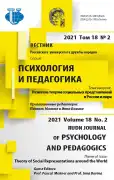From Prototypical Stimuli to Iconographic Stimuli: The Power of Images in the Study of Social Representations
- Autores: Galli I.1, Fasanelli R.1
-
Afiliações:
- The University of Naples Federico II
- Edição: Volume 18, Nº 2 (2021): Theory of Social Representations around the World
- Páginas: 391-401
- Seção: IMAGES AND MEDIA
- URL: https://journal-vniispk.ru/2313-1683/article/view/326016
- DOI: https://doi.org/10.22363/2313-1683-2021-18-2-391-401
- ID: 326016
Citar
Texto integral
Resumo
When we are interested in the image of a social object, we are interested in what individuals have perceived about that object, the ways in which they have interpreted those perceptions, and what they think about that object. Fully agreeing with the idea that the use of iconographic stimuli can enhance the traditional methods and techniques that are used to study any social representation, in this article, two techniques will be presented. The first, the prototypical stimuli technique, was proposed in the second half of the 1980s by Galli and Nigro. The second technique, iconographic stimuli, creatively integrate images and words in a single tool, was designed more recently to study the social representation of culture by Galli, Fasanelli, and Schember. Researches here reviewed clearly shows that the image has the great power to attract to itself the very objects depicted, a power that the word often does not possess. It is images that make people reflect, help them to think about issues concerning the fundamental aspects of everyday life. The work here presented, carried out in first person by the writer, as well as by all the other authors who are concentrating their efforts in this direction, only represents a starting point of reflection. New and more articulated studies will be able to support with heuristic evidence what so far seems to be configured as a suggestive hypothesis, which in any case will require a wider and shared interdisciplinary effort.
Palavras-chave
Sobre autores
Ida Galli
The University of Naples Federico II
Autor responsável pela correspondência
Email: idagalli@unina.it
ORCID ID: 0000-0001-5159-9162
Ph.D., is Full Professor of Social Psychology at the Department of Social Sciences
1 Vico Monte della Pietà, Naples, 80138, Italian RepublicRoberto Fasanelli
The University of Naples Federico II
Email: roberto.fasanelli@unina.it
ORCID ID: 0000-0001-8908-3284
Ph.D. in Health Psychology, individual and social risk prevention, is an Assistant Professor of Social Psychology and Risk Psychology at the Department of Social Sciences
1 Vico Monte della Pietà, Naples, 80138, Italian RepublicBibliografia
- Abric, J.-C. (1987). Coopération, compétition et représentations sociales. Cousset: Del Val.
- Barale, A. (2009). La malinconia dell'immagine: rappresentazione e significato in Walter Benjamin e Aby Warburg. Firenze: Firenze University Press.
- Boehm, G. (2009). La svolta iconica. Modernità, identità, potere. Roma: Meltemi.
- Cacciari, M. (2017). Generare Dio. Bologna: il Mulino.
- Calvino, I. (1988). Lezioni americane. Milano: Garzanti.
- Dallari, M. (2018). Dire le immagini, vedere le parole. Metafore e figure della competenza emotiva. Encyclopaideia, 22(50), 1-20.
- Darras, B. (1998). L’image, une vue de l’esprit. Etude comparée de la pensée figurative et de la pensée visuelle. Recherches en communication, 9, 77-99.
- Rosa, A. S. de, & Farr, R. (2001). Icon and Symbol: Two Sides of the Coin in the Investigation of Social Representations. In F. Buschini & N. Kalampalikis (Eds.), Penser la vie, le social, la nature. Mélanges en hommage à Serge Moscovici (pp. 237-256). Paris: Les Editions de la MSH
- Fasanelli, R., Galli, I., & Piscitelli, A. (2020). Social Representations of Covid-19 in the Framework of Risk Psychology. Papers on social representations. 29(2), 8.1-8.36. Retrieved March 1, 2021, from http://psr.iscte-iul.pt/index.php/PSR/index
- Fasanelli, R., Galli, I., Riverso, R., & Piscitelli, A. (2020). Social Representations of Insects as Food: An Explorative-Comparative Study among Millennials and X-Generation Consumers. Insects, 11(10), 656. https://doi.org/10.3390/insects11100656
- Galli, I. (A cura di). (2008). Del potere e di altri demoni. Napoli: Edizioni Scientifiche Italiane
- Galli, I., & Fasanelli, R. (2020) Public Understanding of Science and Common Sense: Social representations of the human microbiome among the expert and non-expert public. Health Psychology Open, 7(1), 1-14. https://doi.org/10.1177/205510292091323
- Galli, I., & Nigro, G. (1989). L'uso di stimoli prototipici nello studio delle rappresentazioni sociali, Psicologia Italiana, 10(1), 13-20
- Galli, I., Fasanelli, R., & Schember, E. (2018). The construction of icons as a means of access to the social representation of culture. Culture & Psychology, 24(2), 212-232
- Galli, I., Liguori, A., Lorenzi-Cioldi, F., & Fasanelli, R. (2019). Men, Women, and Economic Changes: Social Representations of the Economic Crisis. Interdisciplinaria, 36(2), 283-298. https://doi.org/10.16888/interd.2019.36.2.18
- Lyotard, J.F. (2008). Discorso, figura. Milano: Mimesis
- Mitchell, W.J.T. (2005). What is an Image? New Literary History, 15(3), 503-537
- Molinari, L., & Emiliani, F. (1990). What is an image? The structure of mothers' images of the child and their influence on conversational styles. In G. Duveen & B. Lloyd Bloom (Eds.), Social representations and the development of knowledge (pp. 91-106). Cambridge: Cambridge University Press. https://doi.org/10.1017/CBO9780511659874.006
- Moliner, P. (1996). Images et représentations sociales. Grenoble, France: Presses Universitaires de Grenoble
- Moliner, P. (2008). Représentations sociales et Imagerie Mentale. Communication et Organisation, 34, 13-24. https://doi.org/10.4000/communicationorganisation.547
- Moliner, P. (2016). Psychologie sociale de l’image. Grenoble, France: Presses Universitaires de Grenoble.
- Moscovici, S. (1961). La psychanalyse, son image et son public. Paris: Presses Universitaires de France.
- Warburg, A. (1896-1901). Symbolismus al Umfangsbestimmung (WIA, III.45.1 e III.45.2, p. 23).
Arquivos suplementares









